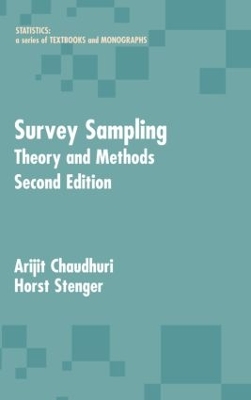Statistics: A Series of Textbooks and Monographs
2 total works
Since publication of the first edition in 1992, the field of survey sampling has grown considerably. This new edition of Survey Sampling: Theory and Methods has been updated to include the latest research and the newest methods. The authors have undertaken the daunting task of surveying the sampling literature of the past decade to provide an outstanding research reference. Starting with the unified theory, the authors explain in the clearest of terms the subsequent developments. In fact, even the most modern innovations of survey sampling, both methodological and theoretical, have found a place in this concise volume.
See what's new in the Second Edition:
Covering the current state of development of essential aspects of theory and methods of survey sampling, the authors have taken great care to avoid being dogmatic and eschew taking sides in their presentation. They have created tool for graduate and advanced level students and a reference for researchers and practitioners that goes beyond the coverage found in most textbooks.
Randomized Response and Indirect Questioning Techniques in Surveys
by Arijit Chaudhuri
For surveys involving sensitive questions, randomized response techniques (RRTs) and other indirect questions are helpful in obtaining survey responses while maintaining the privacy of the respondents. Written by one of the leading experts in the world on RR, Randomized Response and Indirect Questioning Techniques in Surveys describes the current state of RR as well as emerging developments in the field. The author also explains how to extend RR to situations employing unequal probability sampling.
While the theory of RR has grown phenomenally, the area has not kept pace in practice. Covering both theory and practice, the book first discusses replacing a direct response (DR) with an RR in a simple random sample with replacement (SRSWR). It then emphasizes how the application of RRTs in the estimation of attribute or quantitative features is valid for selecting respondents in a general manner. The author examines different ways to treat maximum likelihood estimation; covers optional RR devices, which provide alternatives to compulsory randomized response theory; and presents RR techniques that encompass quantitative variables, including those related to stigmatizing characteristics. He also gives his viewpoint on alternative RR techniques, including the item count technique, nominative technique, and three-card method.

